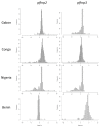Low Prevalence of Plasmodium falciparum Histidine-Rich Protein 2 and 3 Gene Deletions-A Multiregional Study in Central and West Africa
- PMID: 36986377
- PMCID: PMC10054520
- DOI: 10.3390/pathogens12030455
Low Prevalence of Plasmodium falciparum Histidine-Rich Protein 2 and 3 Gene Deletions-A Multiregional Study in Central and West Africa
Abstract
Plasmodium falciparum parasites carrying deletions of histidine-rich protein 2 and 3 genes, pfhrp2 and pfhrp3, respectively, are likely to escape detection via HRP2-based rapid diagnostic tests (RDTs) and, consequently, treatment, posing a major risk to both the health of the infected individual and malaria control efforts. This study assessed the frequency of pfhrp2- and pfhrp3-deleted strains at four different study sites in Central Africa (number of samples analyzed: Gabon N = 534 and the Republic of Congo N = 917) and West Africa (number of samples analyzed: Nigeria N = 466 and Benin N = 120) using a highly sensitive multiplex qPCR. We found low prevalences for pfhrp2 (1%, 0%, 0.03% and 0) and pfhrp3 single deletions (0%, 0%, 0.03% and 0%) at all study sites (Gabon, the Republic of Congo, Nigeria and Benin, respectively). Double-deleted P. falciparum were only found in Nigeria in 1.6% of all internally controlled samples. The results of this pilot investigation do not point towards a high risk for false-negative RDT results due to pfhrp2/pfhrp3 deletions in Central and West African regions. However, as this scenario can change rapidly, continuous monitoring is essential to ensure that RDTs remain a suitable tool for the malaria diagnostic strategy.
Keywords: Central Africa; Plasmodium falciparum; West Africa; histidine-rich protein 2 and 3; pfhrp2/pfhrp3 deletions; rapid diagnostic test.
Conflict of interest statement
The authors declare no conflict of interest.
Figures






Similar articles
-
Investigation of Plasmodium falciparum pfhrp2 and pfhrp3 gene deletions and performance of a rapid diagnostic test for identifying asymptomatic malaria infection in northern Ethiopia, 2015.Malar J. 2022 Mar 4;21(1):70. doi: 10.1186/s12936-022-04097-7. Malar J. 2022. PMID: 35246151 Free PMC article.
-
Deletions of pfhrp2 and pfhrp3 genes were uncommon in rapid diagnostic test-negative Plasmodium falciparum isolates from Uganda.Malar J. 2021 Jan 2;20(1):4. doi: 10.1186/s12936-020-03547-4. Malar J. 2021. PMID: 33386076 Free PMC article.
-
Low prevalence of Plasmodium falciparum parasites lacking pfhrp2/3 genes among asymptomatic and symptomatic school-age children in Kinshasa, Democratic Republic of Congo.Malar J. 2022 Apr 19;21(1):126. doi: 10.1186/s12936-022-04153-2. Malar J. 2022. PMID: 35439987 Free PMC article.
-
Impact of Plasmodium falciparum pfhrp2 and pfhrp3 gene deletions on malaria control worldwide: a systematic review and meta-analysis.Malar J. 2021 Jun 22;20(1):276. doi: 10.1186/s12936-021-03812-0. Malar J. 2021. PMID: 34158065 Free PMC article.
-
Genetic diversity and deletion of Plasmodium falciparum histidine-rich protein 2 and 3: a threat to diagnosis of P. falciparum malaria.Clin Microbiol Infect. 2019 May;25(5):580-585. doi: 10.1016/j.cmi.2018.09.009. Epub 2018 Sep 27. Clin Microbiol Infect. 2019. PMID: 30267926 Review.
Cited by
-
Real-time PCR for malaria diagnosis and identification of Plasmodium species in febrile patients in Cubal, Angola.Parasit Vectors. 2024 Sep 11;17(1):384. doi: 10.1186/s13071-024-06467-3. Parasit Vectors. 2024. PMID: 39261971 Free PMC article.
-
Comparison of SD Bioline Malaria Ag Pf/Pan and Acro Malaria P.f./P.v./Pan with Microscopy and Real Time PCR for the Diagnosis of Human Plasmodium Species.Diagnostics (Basel). 2024 Mar 29;14(7):721. doi: 10.3390/diagnostics14070721. Diagnostics (Basel). 2024. PMID: 38611637 Free PMC article.
-
Genomic Deletion of PfHRP2 and PfHRP3 in Plasmodium falciparum Strains, Ethiopia, 2009.Emerg Infect Dis. 2025 Jul;31(7):1466-1468. doi: 10.3201/eid3107.241676. Emerg Infect Dis. 2025. PMID: 40562737 Free PMC article.
-
Evaluating Malaria Rapid Diagnostic Tests and Microscopy for Detecting Plasmodium Infection and Status of Plasmodium falciparum Histidine-Rich Protein 2/3 Gene Deletions in Southeastern Nigeria.Am J Trop Med Hyg. 2024 Mar 26;110(5):902-909. doi: 10.4269/ajtmh.23-0690. Print 2024 May 1. Am J Trop Med Hyg. 2024. PMID: 38531105 Free PMC article.
-
Prevalence of Plasmodium falciparum parasites with pfhrp2 exon 2 gene deletion in symptomatic malaria patients across Ghana in 2021.Malar J. 2025 May 28;24(1):170. doi: 10.1186/s12936-025-05419-1. Malar J. 2025. PMID: 40437585 Free PMC article.
References
-
- World Health Organization . World Malaria Report 2022. World Health Organization; Geneva, Switzerland: 2022.
-
- Lee N., Baker J., Andrews K.T., Gatton M.L., Bell D., Cheng Q., McCarthy J. Effect of Sequence Variation in Plasmodium falciparum Histidine-Rich Protein 2 on Binding of Specific Monoclonal Antibodies: Implications for Rapid Diagnostic Tests for Malaria. J. Clin. Microbiol. 2006;44:2773–2778. doi: 10.1128/JCM.02557-05. - DOI - PMC - PubMed
LinkOut - more resources
Full Text Sources

